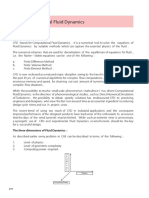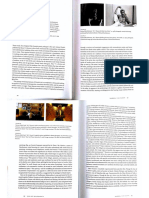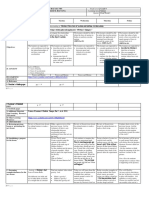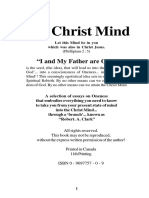Mid Term - 2018 2019
Mid Term - 2018 2019
Uploaded by
alhussenyCopyright:
Available Formats
Mid Term - 2018 2019
Mid Term - 2018 2019
Uploaded by
alhussenyOriginal Title
Copyright
Available Formats
Share this document
Did you find this document useful?
Is this content inappropriate?
Copyright:
Available Formats
Mid Term - 2018 2019
Mid Term - 2018 2019
Uploaded by
alhussenyCopyright:
Available Formats
Ministry of Higher Education Subject: Computational Fluid
and Scientific Research Dynamics
University of Kufa Year: Four\ HVAC&R Branch
Faculty of Engineering Time: Two Hours
Mechanical Engineering Department Examiners: Ahmed Alhusseny
Air-conditioning & Refrigeration Branch Nasr Alkhalidy
Mid-Term Exam
(2018– 2019)
Q1\ A\ Select the correct answer for the questions below:
1- Liquid flows are usually treated as incompressible, but gas flows can also be regarded as
incompressible when Mach number is less than .….....
(a) 1 (b) 0.7 (c) 0.3
2- A differencing scheme is an approximation to compute the …….. values for the convective
terms on the discretised form of the general scalar equation.
(a) cell face (b) cell centre (c) neighboring cells centre
3- The central differencing scheme is not appropriate for problems where convection-diffusion
ratio is………...
(a) equal to 2 (b) less than 2 (c) greater than 2
4- The only unconditionally-bounded differencing scheme is the………………..
(a) QUICK (b) Central (c) first-order upwind
5- For a Newtonian fluid, shear stress proportional to the……….
(a) velocity gradient (b) velocity magnitude (c) pressure gradient
(15 Marks)
Q1\ B\ In any CFD simulation, the following stages are essential. Rearrange them according to their
sequence in a typical simulation.
a) Solve the resulting algebraic equations.
b) Analyse results (calculate derived quantities: forces, flow rates, etc.).
c) Construct a computational mesh (set of control volumes).
d) Discretise the governing equations.
e) Visualise (graphs and plots).
f) Formulate problem (geometry, equations, boundary conditions).
(10 Marks)
Q2\ The figure below shows part of a 2D square finite-volume mesh, with values of a scalar
concentration marked next to the nodes. The accompanying table gives some velocity components
on faces of the central cell. For an incompressible flow, do the following tasks:
a) Use the continuity principle to calculate the missing velocity component vs. (3 Marks)
b) Use the QUICK scheme (defined below) to calculate the value of on each of the central-cell
faces e, w, n, and s. Hence, find the net convective outflow of the physical quantity associated
with (as a multiple of cell-face area A and density ρ). (9 Marks)
c) Use the Van Albada et al. scheme (defined below) to calculate the value of scalar on each
of the central-cell faces e, w, n, and s. Hence, find the net convective outflow of the physical
quantity associated with (as a multiple of cell-face area A and density ρ). (9 Marks)
d) Define the terms transportive and bounded in the context of advection schemes and state
which of these properties is satisfied by each of QUICK and Van Albada et al. (4 Marks)
Data for Q2:
1 3 3
QUICK: ∅𝑓𝑎𝑐𝑒 = − ∅𝑈𝑈 + ∅𝑈 + ∅𝐷
8 4 8
𝑟+𝑟 2
1
∅ + ψ(𝑟)(∅𝐷 − ∅𝐷 ); 𝑖𝑓 𝑚𝑜𝑛𝑜𝑡𝑜𝑛𝑖𝑐 ψ(𝑟 ) =
1+𝑟 2
Van Albada et al.: ∅𝑓𝑎𝑐𝑒 = { 𝑈 2 }, { ∅𝑈 −∅𝑈𝑈
∅𝑈 ; 𝑜𝑡ℎ𝑒𝑟𝑤𝑖𝑠𝑒 𝑟=
∅𝐷 −∅𝑈
Q3\ A fluid property ∅ is transported by means of convection and diffusion through the one-
dimensional domain sketched below. The equation governing the transport phenomenon is the steady
convection-diffusion general scalar equation with boundary conditions of ∅0 = 1 at x = 0 and ∅𝐿 = 0
at x = L. Using three equally spaced cells and each of the Central and Upwind differencing schemes
for convection-diffusion, write the discretised algebraic equations of Ø at each cell for: a) u = -0.2
m/s, b) u = -2.0 m/s. The following data apply: length L = 0.6 m, ρ = 1.0 kg/m3, Γ = 0.1 kg/m·s.
A u B
∅=1 ∅=0
x
(20 Marks)
Q4\ The schematic below illustrates a tank formed from two zones, i.e. liquid and solid. The tank is
heated from the left-side with a time-varying solar heat radiation 𝑞𝑠𝑜𝑙 = 𝑓 (𝑡) 𝑊 ⁄𝑚2 , while the right-
side is kept at a low temperature 𝑇𝑐 . The top surface of the tank is subjected to the ambient conditions,
i.e. (ℎ𝑎𝑖𝑟 & 𝑇𝑎𝑖𝑟 ), while its bottom is thermally insulated. Conjugate heat transfer takes place between
the two-physically different zones through the fluid-solid interface separating them, while fluid flow
is induced due to buoyancy effects where the buoyancy force is approximated according to
Boussinesq formulation 𝐹𝑏𝑢𝑜𝑦𝑎𝑛𝑐𝑦 = 𝜌0 𝛽𝑔(𝑇 − 𝑇0 ). Explain the following:
1- The assumptions required to simulate the below problem. (6 Marks)
2- The conservation equations governing the transport phenomena in each zone. (6 Marks)
3- The boundary conditions closing the mathematical model. (7 Marks)
4- The discretized form of each conservation equation stated in (point 2) above. (6 Marks)
5- The appropriate differencing scheme to be used for the fluid zone if (Pe ≤ 2). (5 Marks)
hair & Tair
Fluid-Solid
Interface
qsol
Solid Tc
Liquid Zone Zone H
ρf, μ, β, cp, kf ρs, cs, ks
Thermally Insulated
Lf Ls
You might also like
- Sample Resume Workday HCM #1Document8 pagesSample Resume Workday HCM #1Pradeep exploreit100% (2)
- Customer Name DOB Income Res City EmployerDocument122 pagesCustomer Name DOB Income Res City EmployerAnshu Gupta50% (2)
- 1st International Symposium On Naval Architecture and Maritime INT-NAM 2011, 24-25 October, Istanbul, Turkey PDFDocument126 pages1st International Symposium On Naval Architecture and Maritime INT-NAM 2011, 24-25 October, Istanbul, Turkey PDFYuriyAKNo ratings yet
- Batch CSTR ExperimentDocument5 pagesBatch CSTR ExperimentDyako D TaherNo ratings yet
- CH 1. Mathematical Formulation of Physicochemical Problems PDFDocument23 pagesCH 1. Mathematical Formulation of Physicochemical Problems PDFDea Puspa Karinda 02211940000031No ratings yet
- Sample Exam Questions (And Answers)Document22 pagesSample Exam Questions (And Answers)Diem Hang VuNo ratings yet
- 1st Attempt Final Exam-Term - 2018-2019Document2 pages1st Attempt Final Exam-Term - 2018-2019alhussenyNo ratings yet
- 2nd Attempt Final Exam-Term - 2018-2019Document2 pages2nd Attempt Final Exam-Term - 2018-2019alhussenyNo ratings yet
- 1st Attempt Final Exam-Term - 2019-2020Document2 pages1st Attempt Final Exam-Term - 2019-2020alhussenyNo ratings yet
- Super Imposed FlowsDocument4 pagesSuper Imposed FlowssuriyaanaNo ratings yet
- Chapter 2Document51 pagesChapter 2yungP100% (2)
- Unit Iv Shell Mass Balances and Boundary Conditions:: Mass Transfer in Respect of Diffusion Through A Stagnant Film'Document14 pagesUnit Iv Shell Mass Balances and Boundary Conditions:: Mass Transfer in Respect of Diffusion Through A Stagnant Film'3004 Divya Dharshini. MNo ratings yet
- Thermal (TE-411,412,413,414,511)Document25 pagesThermal (TE-411,412,413,414,511)nved01No ratings yet
- ENGI9901/ME8506 Fluid Dynamics, Winter 2022 Assignment#3: Due: Wednesday, March 2, 2022, 11:00 PMDocument2 pagesENGI9901/ME8506 Fluid Dynamics, Winter 2022 Assignment#3: Due: Wednesday, March 2, 2022, 11:00 PMCodey Carter PikeNo ratings yet
- Assignment2 QuestionsDocument2 pagesAssignment2 QuestionsPaartiban PaneerselvamNo ratings yet
- Theoretical Calculations of The Distribution of Aerodynamic Loading On A Delta WingDocument35 pagesTheoretical Calculations of The Distribution of Aerodynamic Loading On A Delta WingHarsha HarNo ratings yet
- Simulation of Two-Phase Flows in Vertical Tubes With The CFDDocument12 pagesSimulation of Two-Phase Flows in Vertical Tubes With The CFDdigecaNo ratings yet
- AMT Ht16-Exam PDFDocument9 pagesAMT Ht16-Exam PDFaamersid2882No ratings yet
- Finite Difference Method To Solve Incompressible Fluid FlowDocument20 pagesFinite Difference Method To Solve Incompressible Fluid FlowVrayan AyalaNo ratings yet
- Assignment 3Document3 pagesAssignment 3Vandit GoyalNo ratings yet
- Fde312-Part IiDocument32 pagesFde312-Part Iiprince amerNo ratings yet
- Flow Across Tube BanksDocument11 pagesFlow Across Tube BanksAliAlMaestroNo ratings yet
- Steady Supersonic Flow Over Right Circular ConeDocument9 pagesSteady Supersonic Flow Over Right Circular Conecal linNo ratings yet
- Tablas TermotecniaDocument28 pagesTablas TermotecniaAcademia SanRoqueNo ratings yet
- 2nd Term - 2018 2019Document2 pages2nd Term - 2018 2019alhussenyNo ratings yet
- RLC TransientDocument3 pagesRLC TransientMadhur SharmaNo ratings yet
- Topics: Equilibrium and Stability Criteria, The VDW Equation of State, The MaxwellDocument9 pagesTopics: Equilibrium and Stability Criteria, The VDW Equation of State, The MaxwellAkshat GuptaNo ratings yet
- Calculation of Seepage Discharge and Seepage PressureDocument9 pagesCalculation of Seepage Discharge and Seepage Pressuresaeed-2167% (3)
- Gasdynamics 2023 2024 Task1Document13 pagesGasdynamics 2023 2024 Task1sanj2498No ratings yet
- Problemsheet 2Document6 pagesProblemsheet 2Kush ShahNo ratings yet
- PhysRevE 80 061138Document13 pagesPhysRevE 80 061138xvw584d27zNo ratings yet
- Airbus Quantum Computing Challenge PS2 March 2019Document10 pagesAirbus Quantum Computing Challenge PS2 March 2019Wish SNo ratings yet
- Vancouver2003 ABDocument6 pagesVancouver2003 ABSHUBHAMNo ratings yet
- ρVD μ VD vDocument4 pagesρVD μ VD vaefNo ratings yet
- MEG506 - Exam - 2020 - 21 - Model Answers and Marking SchemeDocument6 pagesMEG506 - Exam - 2020 - 21 - Model Answers and Marking Schemeajahbenjamin1No ratings yet
- Buoyancy Induced Flow in A CavityDocument11 pagesBuoyancy Induced Flow in A Cavitysk21meb0b55No ratings yet
- The Four Laws of Black Hole MechanicsDocument5 pagesThe Four Laws of Black Hole MechanicsRaj KomolNo ratings yet
- Design and Analysis of Wind Turbines Using Helicoidal Vortex ModelDocument5 pagesDesign and Analysis of Wind Turbines Using Helicoidal Vortex Modelsokak009No ratings yet
- System-Level Analysis of Chilled Water Systems Aboard Naval ShipsDocument6 pagesSystem-Level Analysis of Chilled Water Systems Aboard Naval ShipsAlin NanuNo ratings yet
- Semester 1 Examinations 2015/2016: Dublin City UniversityDocument8 pagesSemester 1 Examinations 2015/2016: Dublin City UniversityfuckoffmanNo ratings yet
- Ph.D. Qualifying Examination Department of Physics and Astronomy Wayne State UniversityDocument7 pagesPh.D. Qualifying Examination Department of Physics and Astronomy Wayne State UniversityjonsNo ratings yet
- Chapter 2 (A) Principles of Unsteady-State Mass TransferDocument20 pagesChapter 2 (A) Principles of Unsteady-State Mass TransferLa Casa JordanNo ratings yet
- P3 CFDDocument6 pagesP3 CFDMahtab MohebbiNo ratings yet
- Sinusoidal AC Circuit MeasurementsDocument17 pagesSinusoidal AC Circuit MeasurementsComputer Guru100% (4)
- Flow Reactor Models For Fluid-Fluid Systems, Based On The Two-Film TheoryDocument6 pagesFlow Reactor Models For Fluid-Fluid Systems, Based On The Two-Film TheoryFadwah MokhtarNo ratings yet
- Chapter 16 - CFD PDFDocument28 pagesChapter 16 - CFD PDFdeepakNo ratings yet
- Elder 1967Document15 pagesElder 1967ALEJANDRO GANCEDO TORALNo ratings yet
- The Electronic Adiabatic-To-Diabatic Transformation Matrix and The Wigner Rotation MatrixDocument8 pagesThe Electronic Adiabatic-To-Diabatic Transformation Matrix and The Wigner Rotation MatrixAndrew LiebermannNo ratings yet
- اسئلة امتحان تنافسيDocument26 pagesاسئلة امتحان تنافسيHamed MasterNo ratings yet
- TK 3 5 PDFDocument47 pagesTK 3 5 PDFAyat HomanNo ratings yet
- Leaching Apparatus Experimental ManualDocument12 pagesLeaching Apparatus Experimental ManualShoaib PathanNo ratings yet
- Keady, COLEBROOK-WHITE FORMULA FOR PIPE FLOWSDocument6 pagesKeady, COLEBROOK-WHITE FORMULA FOR PIPE FLOWSDang HongNo ratings yet
- Lab 1 ThaDocument3 pagesLab 1 Thameriemmalika.aibNo ratings yet
- Mass Transfer Mass Transfer Coefficients Notes 10-11-2015Document28 pagesMass Transfer Mass Transfer Coefficients Notes 10-11-2015John OliverNo ratings yet
- Qual Exam Jan2017Document6 pagesQual Exam Jan2017gasperogandhiNo ratings yet
- Problem Set 2 20161 4Document3 pagesProblem Set 2 20161 4qoo30115No ratings yet
- COBEM 2021 - Luciene - 32587Document9 pagesCOBEM 2021 - Luciene - 32587Paulo TrevizoliNo ratings yet
- Integrating CFD and Building SimulationDocument7 pagesIntegrating CFD and Building SimulationJoaquim MonteiroNo ratings yet
- Reviews in Computational ChemistryFrom EverandReviews in Computational ChemistryAbby L. ParrillNo ratings yet
- Chapter Eight - Vapour Compression CycleDocument37 pagesChapter Eight - Vapour Compression Cyclealhusseny100% (1)
- High-Porosity Metal Foams Potentials, Applications, and FolmulationsDocument21 pagesHigh-Porosity Metal Foams Potentials, Applications, and FolmulationsalhussenyNo ratings yet
- Chapter 1 - Basics of Heat Transfer PDFDocument14 pagesChapter 1 - Basics of Heat Transfer PDFalhussenyNo ratings yet
- Chapter Seven - Ducts and Fans SystemsDocument23 pagesChapter Seven - Ducts and Fans Systemsalhusseny100% (1)
- Computational Fluid Dynamics The Basics With Applications Anderson J DDocument563 pagesComputational Fluid Dynamics The Basics With Applications Anderson J Dchandrasingh4564100% (1)
- Syllabus Cyber Security and Web TechnologiesDocument2 pagesSyllabus Cyber Security and Web TechnologiesDr MadhurimaNo ratings yet
- 507 33 Powerpoint-Slides DRCS Ch19Document150 pages507 33 Powerpoint-Slides DRCS Ch19Arun GoyalNo ratings yet
- Proforma For Nomination of Best Outgoing Student AwardDocument9 pagesProforma For Nomination of Best Outgoing Student AwardSiva ShankarNo ratings yet
- Azure Devops SyllabusDocument7 pagesAzure Devops SyllabusAnil N100% (1)
- Unit 5 Short Test 1B: GrammarDocument1 pageUnit 5 Short Test 1B: GrammarMinh TruongNo ratings yet
- Fiji Hindi - English DictionaryDocument52 pagesFiji Hindi - English DictionaryJulia AndengNo ratings yet
- 3 - Sonal Khullar - Worldly Affiliations - Artistic Practice, National Identity, and Modernism in India, 1930 - 1990-HusainDocument20 pages3 - Sonal Khullar - Worldly Affiliations - Artistic Practice, National Identity, and Modernism in India, 1930 - 1990-HusainJanhavi Mohan BhogeNo ratings yet
- Annual Report 2017-18 eDocument81 pagesAnnual Report 2017-18 eVignesh KrishnamoorthyNo ratings yet
- Case Summary Ovarian CystDocument4 pagesCase Summary Ovarian CystFrancesca AkanjiNo ratings yet
- Lecture 4Document8 pagesLecture 4nkalampumelelo82No ratings yet
- Credit Risk Management 2017Document31 pagesCredit Risk Management 2017nazmulhossain01011997No ratings yet
- Women and Nutrition: Victims or Decision Makers: Ms - Indu Capoor and Chetna TeamDocument11 pagesWomen and Nutrition: Victims or Decision Makers: Ms - Indu Capoor and Chetna TeamfadligmailNo ratings yet
- Roshan Data Entry Work LONDON 25 02 2022Document46 pagesRoshan Data Entry Work LONDON 25 02 2022arun945330No ratings yet
- See Also Notes References: Brahmanas Brihadaranyaka UpanishadDocument1 pageSee Also Notes References: Brahmanas Brihadaranyaka UpanishadRupai SarkarNo ratings yet
- DLL Science Grade8 Quarter1 Week2Document8 pagesDLL Science Grade8 Quarter1 Week2Gerald E BaculnaNo ratings yet
- Cyberpunk AdDocument6 pagesCyberpunk AdAmanda AlexanderNo ratings yet
- Abuja Industrial ParkDocument17 pagesAbuja Industrial ParkChinedu OkoroNo ratings yet
- DLL 5SDocument5 pagesDLL 5SAngelo VillanuevaNo ratings yet
- The Christ Mind: "I and My Father Are One"Document440 pagesThe Christ Mind: "I and My Father Are One"pajodream777No ratings yet
- Evalhvled805: 4.2 W Off-Line LED Driver With Primary Side RegulationDocument9 pagesEvalhvled805: 4.2 W Off-Line LED Driver With Primary Side RegulationtitoelectrosniscoNo ratings yet
- Asian Terminals, Inc Vs Allied Guarantee InsuranceDocument7 pagesAsian Terminals, Inc Vs Allied Guarantee InsuranceRomy Ian LimNo ratings yet
- Plinth VocabDocument121 pagesPlinth VocabMister HemsNo ratings yet
- Sodium Stearyl FumarateDocument2 pagesSodium Stearyl FumarateAldo Ilyan Perez MendezNo ratings yet
- Romana Tema (Ajutor) Homo LudensDocument6 pagesRomana Tema (Ajutor) Homo LudensDobre RobertNo ratings yet
- Analysis of To Kill A MockingbirdDocument5 pagesAnalysis of To Kill A MockingbirdEugen ZolotNo ratings yet
- ARUEGO Vs CA Case DigestDocument2 pagesARUEGO Vs CA Case DigestKim Lorenzo CalatravaNo ratings yet
- Dec 2018Document1 pageDec 2018Bharat YadavNo ratings yet






























































































